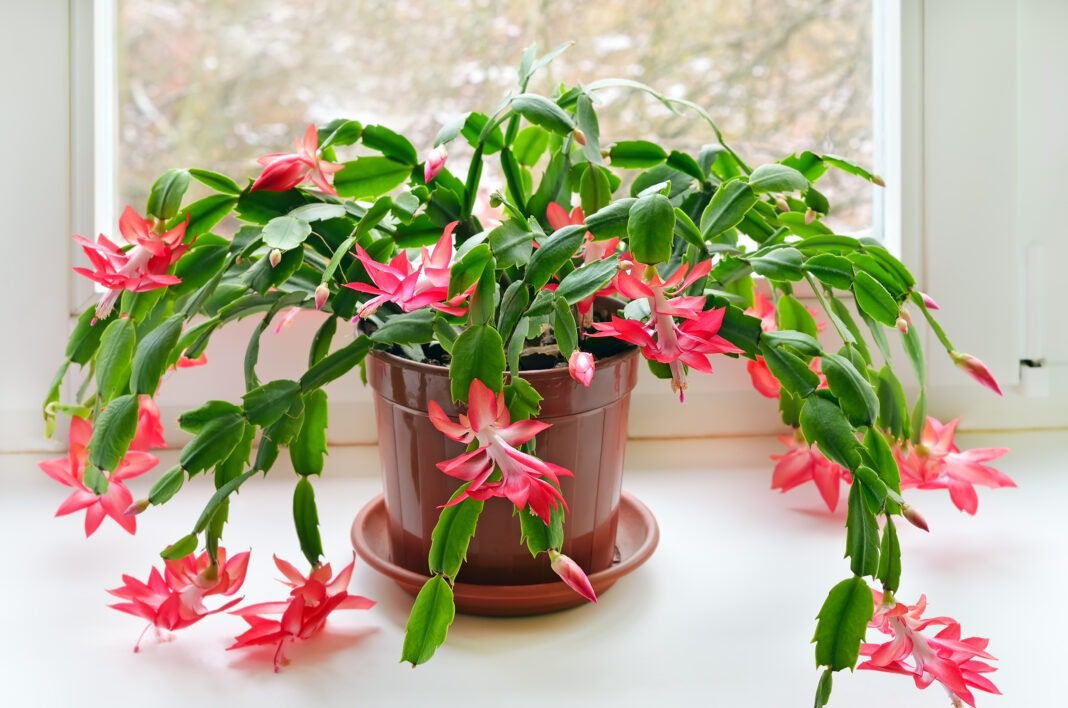Know in one minute about Christmas cactus care
|
Introduction
Christmas cactus (Schlumbergera bridgesii; family Cactaceae), is a common flowering pot plant. It is different from other cacti that are native to arid desert climates. This plant is also known as Epiphytic Cactus (surface growers), those plants which live on other plants. They grew primarily for autumn and winter sales and bloomed indoors about Christmastime in the Northern Hemisphere. All the genus of Schlumbergera is native to the coastal mountains of southeast Brazil. Christmas cactus care is easy and produces attractive flowers.
Botanical description
Christmas cactus has dark-green flattened stems (leaf-like) that are joined by glossy green segments. These leaves have rounded teeth on the margins of the leaves. The hanging branches can grow to up to 3 feet long. Flowers emerge at the tips of the stems, about 2 in (5 cm) long. The flower is available in red, white, golden yellow, pink, or purple.
Common name
Forest cactus, Christmas Cactus, True Christmas Cactus, Holiday Cactus, Link Cactus, Grandmother’s Cactus.
How Christmas cactus propagates
Christmas cactus can be easy to propagate in sandy soil using stem cuttings (Y-shape segment) and splitting. If the base of the plant becomes woody, it’s a great sign because it helps to create more Christmas cacti.
Christmas cactus care
The Christmas cactus blooms for a long time indoors with proper care. This plant is easy to care and propagate thus it is very popular as a holiday gift-giving. Let’s look at some of the conditions to obtain good plant growth.
1. Soil and water
Plant the Christmas cactus in light well-drained soil that is rich in humus and other nutrients. This plant requires moisture for better growth, so keep watering when the top inch or 2 of soil is dry. Remove excess water because it may cause rotting of roots and stems. Overwatering may cause soft, mushy, or yellow stems and brown spots on the leaves
2. Humidity
Try to maintain the humidity level in the range between 50-60% is better for growth. Placing the pot on a tray of pebbles and water can add more humidity to drier surroundings.
3. Fertilizer
Applying a mild fertilizer solution every 2 weeks helpful for its growth. Also, provide a low amount of vermicompost every 3 months good for blooming.
4. Avoid direct sunlight
Christmas cactus readily induces flowers, if exposed to brighter light but too much light burns its leaves (turning purplish-red). So keep the Christmas cactus in a shady area or bright indirect light to avoid this problem. Moreover, if you want to put this plant indoors, make sure the plant receives 12-14 hours of darkness by black cloth or a plastic bag, or place it in a closet.
5. Temperature
Christmas cactus temperature is important as well, it can tolerate low to high temperatures. To encourage flowering keep the plant 55 and 65 degrees. When buds appear, the temperature should be between 60 and 70 degrees F. (15-21 C.). Also, increase humidity around the plant by placing a tray of pebbles filled with water beneath the Christmas cactus container
6. Repotting
Repotting of Christmas cactus should be done in 1-2 years in spring or early summer and keep up the humidity. Prune the Christmas cactus after blooming is effective to obtain the best shape and improves the uniformity of flowering. During the repotting transfer the root with care without disturbance.
Note: Avoid any type of stress like the amount of light, or a sudden change in temperature, overwatering may cause a drop of flower buds, drop its blossoms.
Side effect of Christmas cactus
1. Risk of allergy
This plant may cause urticaria (swollen, pale red bumps) with symptoms like sneezing, itching of the eyes. Also, cause puffy eyes (swelling around the eyes), and asthmatic dyspnea (chest tightness) this may cause allergy when handling these cacti (1).
2. May cause rhinoconjunctivitis
Regular contact with Christmas cactus may cause rhinoconjunctivitis in humans. The patient feels symptoms like sneezing or a runny or a blocked nose without a cold or flu. Also, cause itching of the nose or eyes and red eyes (conjunctivitis) (2).
The cutting should consist of at least two or three joined segments. Allow the cutting to dry a few hours before potting it up for rooting, to avoid excessive moisture. Place the segment about a quarter of its length below the soil surface.
3. Toxic for pats
Ingestion of Christmas cactus is toxic for dogs and cats, it may irritate the gastrointestinal tract. After ingestion, it may cause vomiting (with or without blood), diarrhea (with or without blood), depression, and anorexia (eating disorder).
Intake of this plant also causes ataxia (brain damage) in cats. However, these signs are mild and stay until they digest but it is dangerous for aged animals (3).
Q&A
How often do you water a Christmas cactus?
The plant needs moisture, so water the plant when the top inch or 2 of soil is dry. Keep in this mind to remove excess water from the pot because overwatering may cause yellow stem, rotting.
Does Christmas cactus need a lot of sun?
Nope, Christmas cactus needs indirect bright light so put the pot on a shady area or porch.
Is a Christmas cactus a real cactus?
Christmas cactus is more like tropical plants than desert plants. It is an indoor houseplant and needs high humidity.
Why is my Christmas cactus limp?
Christmas cactus limps because the plant did not receive enough water and the potting medium is dry out. To solve this problem, water the plant frequently during hot weather so its soil stays moist.
